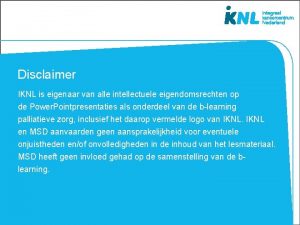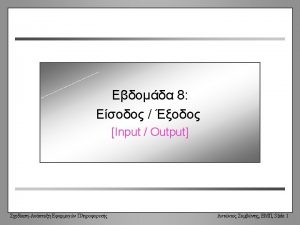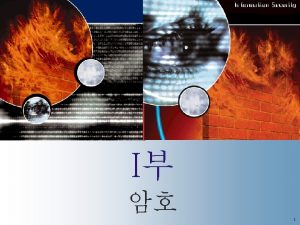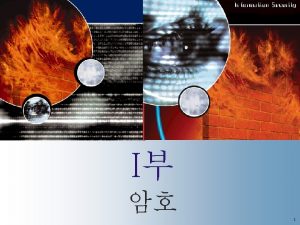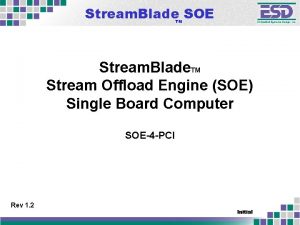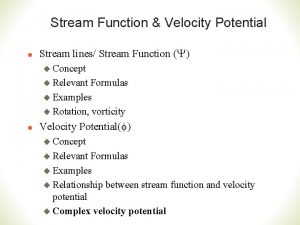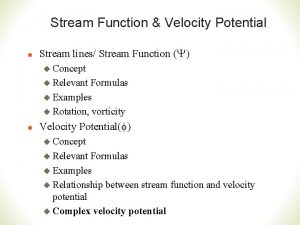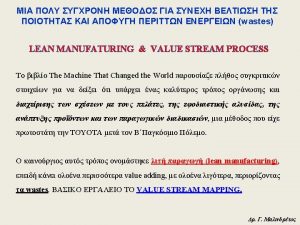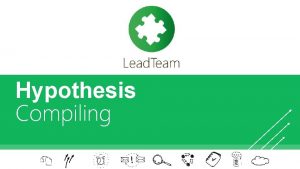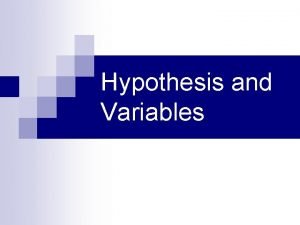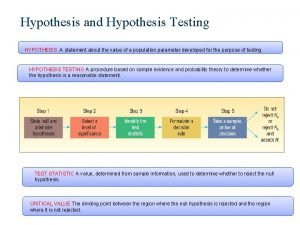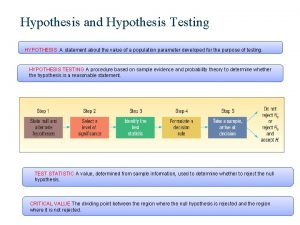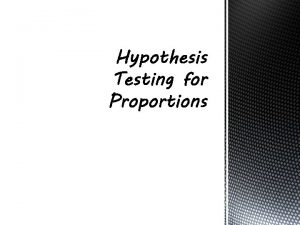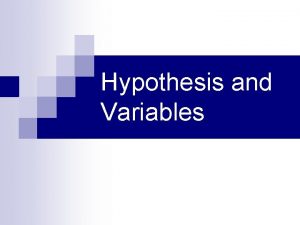The Three Stream Hypothesis Rizzolatti Matelli 2003 Talk






























- Slides: 30

The Three Stream Hypothesis Rizzolatti & Matelli (2003)

Talk Outline 1. Stream Localization 2. Lesional Correlates 3. Parieto-Premotor Circuits 4. Stream Topology

Two Dual Stream traditions “What” stream & “How” stream Goodale & Milner (1992) Jeannerod (1994) “What” stream & “Where” stream Mishkin et al (1982)

Left Hemisphere Flat Map Limbic Lobe Parietal M 1/S 1 Frontal A 1 P F T O Temporal Lobe l ita cip Oc obe L Lobe Fro Pariet Lobe al Lobe V 1

Three Streams: “How”, “Where”, “What” Dorso-Dorsal “How” Stream Ventro-Dorsal “Where” Stream PMd Ventral “What” Stream SPL PMv sm. G an. G

Reconciling The Traditions Dorso-Dorsal “How” Stream Perceptually Guides Action Goodale & Milner Ventro-Dorsal “Where” Stream PMd Supports Spatial Reasoning SPL Computes Object Features sm. G an. G PMv Ventral “What” Stream Mishkin et al

Bisecting Ventro-Dorsal Stream The ventro-dorsal stream (IPL & v. PMC) exhibits strong lateralization effects. The right ventro-dorsal stream supports spatial reasoning and attention. The left ventro-dorsal stream computes affordances. The other streams show less evidence of lateralization.

Dual Stream Models of Speech Processing In recent years, dual stream models of speech processing have been put forward. ● ● Rauscheck & Scott (2009). Maps and streams in the auditory cortex: nonhuman primates illuminate human speech processing Hickok & Poeppel (2007). The cortical organization of speech processing In this literature: Left lateral stream: speech production Right lateral stream: audio spatial analysis Ventral stream: audio features & speech comprehension. We can integrate these models into the Three Stream Hypothesis

Dorso-Dorsal “How” Stream PMd Integrating Audition Ventro-Dorsal “Where” Stream Ventral “What” Stream SPL PMv sm. G an. G Primary Audio cortex

Dorso-Dorsal“How”Stream Ventro-Dorsal Lateral“Where”Stream Summing Up Ventral “What” Stream Prefrontal Cortex Premotor Cortex Dorsolateral PFC (DLPFC) Dorsal Premotor (PMd) Ventrolateral PFC (VLPFC) Ventral Premotor (PMv) Superior Parietal Lobule (SPL) Intraparietal Sulcus (IPS) Inferior Parietal Lobule (IPL) SPL IPL PMv Posterior Parietal Cortex PMd Let’s rename our streams. . .

Talk Outline 1. Localizing The Streams 2. Lesional Dissociations 3. Identifying Parieto-Premotor Subcircuits 4. Stream Topology

Blindsight Lesions to V 1 eliminate conscious experience of vision. However, some visual information reaches the dorsal stream, via the pulvinar. This “leakage” produces the phenomenon of blindsight: People unable to tell you where objects are, but when forced to guess, will get it right far above chance levels. This was the original motivation for Goodale/Milner’s “How” visual stream.

Hemispatial Neglect is an attentional disorder. Hemispatial neglect is an impaired ability to attend to one half of space. Hemispatial neglect is much more common for the left hemifield. Itis associated with lesions in the right lateral stream. Model Patient’s Drawing

Lesional Evidences Optic ataxia is a reaching disorder, most pronounced when object is in peripheral vision. This disorder is caused by lesions on SPL. Apraxia is an impaired ability to make gestures. Ideomotor apraxia has this impairment only when subject is not in an appropriate context. This disorder is caused by lesions on IPL.

Neurotypical Optic Ataxia Hemispatial Neglect Ideomotor Apraxia Blindsight Dorsal stream Right lateral stream Ventral stream We can see a taxonomy of lesions begin to emerge, based on which stream has been compromised. Left lateral stream Lesions & Streams

Talk Outline 1. Stream Localization 2. Behavioral Correlates 3. Parieto-Premotor Circuits 4. Stream Topology

Dorsal Stream Lateral Stream Improving Parcellation Granularity Prefrontal Cortex Premotor Cortex Dorsolateral PFC (DLPFC) F 2 vr Dorsal Premotor F 7 (PMd) F 2 d Ventrolateral PFC (VLPFC) F 5 ab. Premotor Ventral F 4 F 5 c (PMv) PE PEc Superior Parietal Lobule (SPL) PEip MIP Intraparietal Sulcus VIP (IPS) LIP AIP Inferior Parietal Lobule (IPL) PF PFG PG PMd SPL IPL PMv Posterior Parietal Cortex Ventral Stream

Five Circuits Lateral circuits VIP→F 4: Reaching & Peripersonal Space AIP→F 5 ab: Grasping Objects PF→ F 5 c: Action Understanding Premotor Cortex F 7 F 2 vr F 2 d F 5 ab F 5 c Dorsal circuits 1 PEc / PEip → F 2 d: Online Guidance MIP → F 2 vr: Visuomotor transformations 1. Matelli et al (1998). Superior Area 6 Afferents From the Superior Parietal Lobule in the Macaque Monkey Posterior Parietal Cortex PE PEc PEip MIP VIP F 4 LIP AIP PF PFG PG

Peripersonal Space The perceptual difference between an object 2 ft and 6 ft away is not especially large. However, only objects in peripersonal space can be reached by the organism. The brain has a separate system which elaborates nearby affordances. This dissociation is evidenced by peripersonal neglect. Peripersonal Space Extrapersonal Space

VIP → F 4: Reaching & Peripersonal Space F 4 fires during arm and hand reaching movements. Electrical microstimulation induce a variety of shoulder, neck, and face movements. Lesions can induce both contralateral peripersonal neglect, and motor disorders F 7 F 5 ab F 5 c F 2 vr F 2 d PE PEc PEip MIP VIP F 4 LIP AIP PF PFG PG

About F 5 Trimodal (audio/visual/haptic) neurons have been discovered throughout F 5. 1 This region seems to participate in the audio lateral stream. F 7 F 5 ab F 5 c The human analogue to macaque F 5 is BA 45: Broca’s Area Pars Opercularis. 1. Rizzolatti, Fogassi, Gallese (2002): Motor and cognitive functions of the ventral premotor cortex F 2 vr F 2 d PE PEc PEip MIP VIP F 4 LIP AIP PF PFG PG

AIP → F 5 ab: Grasping F 5 neurons encode hand mouth movements. Three classes of AIP neurons: visual dominant, bimodal, motor dominant. Grasp in daylight Grasping in darkness Visual Dominant 100% 0% Bimodal 100% 50% Haptic Dominant 100% F 7 F 5 ab F 5 c F 2 vr F 2 d PE PEc PEip MIP VIP F 4 LIP AIP PF PFG PG

PF → F 5 c: Action Understanding F 5 c, the dorsal section of Pars Opercularis, contains mirror neurons. Mirror neurons have two interesting properties: F 7 F 5 ab 1. Their representations are person-agnostic. 2. They enable percept-motor transduction. They are generally viewed as facilitating action understanding. However, they may also be an important prerequisite for language. F 5 c F 2 vr F 2 d PE PEc PEip MIP VIP F 4 LIP AIP PF PFG PG

Summarizing The Parieto-Premotor Circuits Dorsal circuits: Online Guidance, Visuomotor transformations These circuits enable dynamic behavior patterns (variable affordances 1) Lateral circuits: Reaching & Peripersonal Space, Grasping Objects, Action Understanding These circuits enable long-term behavioral memory (stable affordances) What became of the “What” vs “Where” distinction? 1. Binkofski, Buxbaum (2012) Two action systems in the human brain. S P IL P L

Talk Outline 1. Stream Localization 2. Behavioral Correlates 3. Parieto-Premotor Circuits 4. Stream Topology

Dorsal Stream Lateral Stream Broader View Of Streams Ventral Stream PMd We’ve examined parietial → premotor circuits. SPL But what circuits operate earlier (extrastriate)? PMv IPL And later (prefrontal)?

Color Key Three Stages Perception Area Action Area Stage Two Stage Three DLPFC PMd Variable Affordances M 1 VLPFC PMv TE Stage One SPL S 1 Stable Affordances IPL TEO V 1

Dorsal Stream Lateral Stream Searching for “What” vs “Where” Ventral Stream We can abbreviate stream-stage pairs: “Dorsal Stream, Stage 2” → DS 2 DS 3 LS 3 So let’s turn to LS 1 and VS 1. DS 1 LS 2 PMv Extrapersonal space isn’t encoded by DS 2 or LS 2. PMd DS 2 LS 1 VS 2

Dorsal Stream Lateral Stream Dual-Representation Categories Ventral Stream DS 3 PMd Regions of interest (ROIs) come in pairs. We don’t have one face selective area, but two. These pairs are clustered in two regions. DS 2 Lateral Stream DS 1 LS 3 PMv LS 2 VS 2 1. Schwarzlose et al (2007). The distribution of category and location information across object-selective regions in human visual cortex. Ventral Stream Objects LO p. Fs Bodies EBA Faces EFA FFA Places TOS PPA These regions correspond with different functions: ● The lateral region encodes location. ● The ventral region encodes features.

Color Key The Three Streams Hypothesis DLPFC PMd Variable Affordances M 1 Lateral Stream VLPFC PMv Sp Com eech prehe nsion Ventral Stream Action Area Stage Two Stage Three Dorsal Stream Perception Area TE Stage One SPL S 1 Stable Affordances IPL A 1 AC Locations a Fe ech Spe ction du Pro TEO es tur V 1
 Differentiate byte stream and character stream
Differentiate byte stream and character stream Talk, read, talk, write resources
Talk, read, talk, write resources Amateurs discuss tactics professionals discuss logistics
Amateurs discuss tactics professionals discuss logistics Problem talk vs solution talk
Problem talk vs solution talk Example of null hypothesis
Example of null hypothesis Developing null and alternative hypothesis
Developing null and alternative hypothesis Null and alternative hypothesis examples
Null and alternative hypothesis examples Nebular hypothesis and protoplanet hypothesis venn diagram
Nebular hypothesis and protoplanet hypothesis venn diagram Three talk model
Three talk model Traditional media channel
Traditional media channel Hát kết hợp bộ gõ cơ thể
Hát kết hợp bộ gõ cơ thể Slidetodoc
Slidetodoc Bổ thể
Bổ thể Tỉ lệ cơ thể trẻ em
Tỉ lệ cơ thể trẻ em Gấu đi như thế nào
Gấu đi như thế nào Glasgow thang điểm
Glasgow thang điểm Hát lên người ơi alleluia
Hát lên người ơi alleluia Môn thể thao bắt đầu bằng từ chạy
Môn thể thao bắt đầu bằng từ chạy Thế nào là hệ số cao nhất
Thế nào là hệ số cao nhất Các châu lục và đại dương trên thế giới
Các châu lục và đại dương trên thế giới Công của trọng lực
Công của trọng lực Trời xanh đây là của chúng ta thể thơ
Trời xanh đây là của chúng ta thể thơ Mật thư tọa độ 5x5
Mật thư tọa độ 5x5 Phép trừ bù
Phép trừ bù Phản ứng thế ankan
Phản ứng thế ankan Các châu lục và đại dương trên thế giới
Các châu lục và đại dương trên thế giới Thơ thất ngôn tứ tuyệt đường luật
Thơ thất ngôn tứ tuyệt đường luật Quá trình desamine hóa có thể tạo ra
Quá trình desamine hóa có thể tạo ra Một số thể thơ truyền thống
Một số thể thơ truyền thống Cái miệng nó xinh thế
Cái miệng nó xinh thế Vẽ hình chiếu vuông góc của vật thể sau
Vẽ hình chiếu vuông góc của vật thể sau








